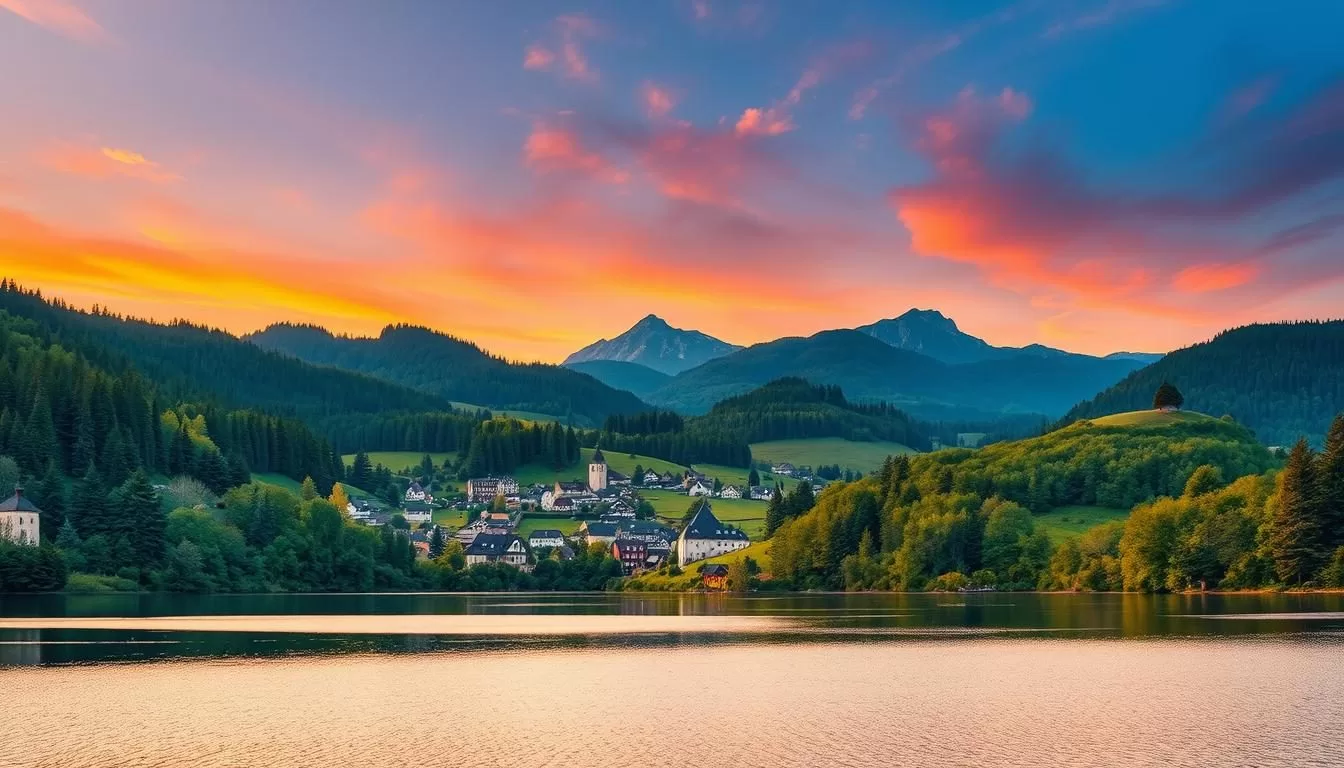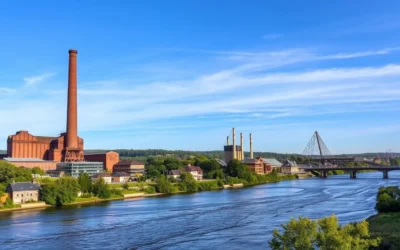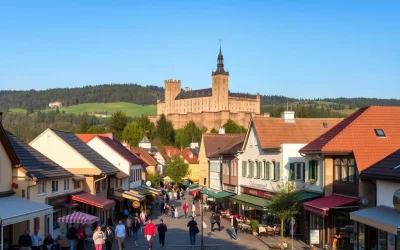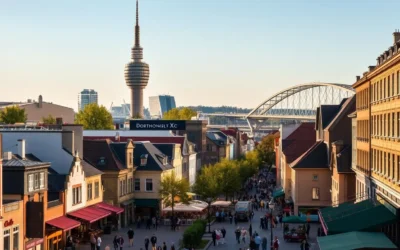✓ Accommodations✓ Flights✓ Rental Cars
Planning your visit to this stunning region can make all the difference in your travel experience. The weather here varies significantly throughout the year, offering unique opportunities depending on when you go. From blooming cherry blossoms in spring to festive winter markets, every season has something special to offer.
Choosing the best time to visit ensures you enjoy pleasant conditions and avoid large crowds. Mid-September, for example, is ideal for outdoor activities, with warm temperatures perfect for exploring. Meanwhile, late September brings vibrant autumn colors and fewer tourists, making it a sensational time visit.
Whether you’re strolling through charming towns or enjoying local festivals, timing your trip around the weather can enhance your adventure. With careful planning, you’ll create unforgettable memories in this picturesque destination.
Introduction: Planning Your Weather-Savvy Visit
Timing your trip to align with the seasons can transform your travel experience. Each season brings unique opportunities, from vibrant summer festivals to cozy winter markets. Understanding these changes ensures you make the most of your visit.
Why Seasonality Makes a Difference
Seasonality plays a key role in shaping your travel plans. In summer, you’ll find lively festivals and outdoor biergartens. Winter, on the other hand, offers magical Christmas markets and snowy landscapes. Temperature variations also affect what activities are available, so planning ahead is essential.
What to Expect from Your Trip
Your trip will vary greatly depending on the season. Summer is perfect for exploring outdoor events and enjoying warm weather. Winter invites you to experience festive markets and winter sports. By aligning your visit with local events and weather, you’ll avoid peak crowds and enjoy a smoother adventure.
| Season | Highlights | Tips |
|---|---|---|
| Summer | Festivals, biergartens, warm weather | Book accommodations early to avoid high prices |
| Winter | Christmas markets, winter sports, cozy vibes | Pack warm clothing and check event schedules |
Planning your trip with both local events and weather in mind ensures a memorable and enjoyable experience. Whether you’re exploring summer festivals or winter markets, timing is everything.
Understanding Germany’s Distinct Seasons
Each season brings its own charm and unique experiences. Whether you’re drawn to blooming landscapes or festive vibes, understanding the rhythm of the seasons can enhance your travel plans. From mild spring days to crisp fall breezes, every month offers something special.
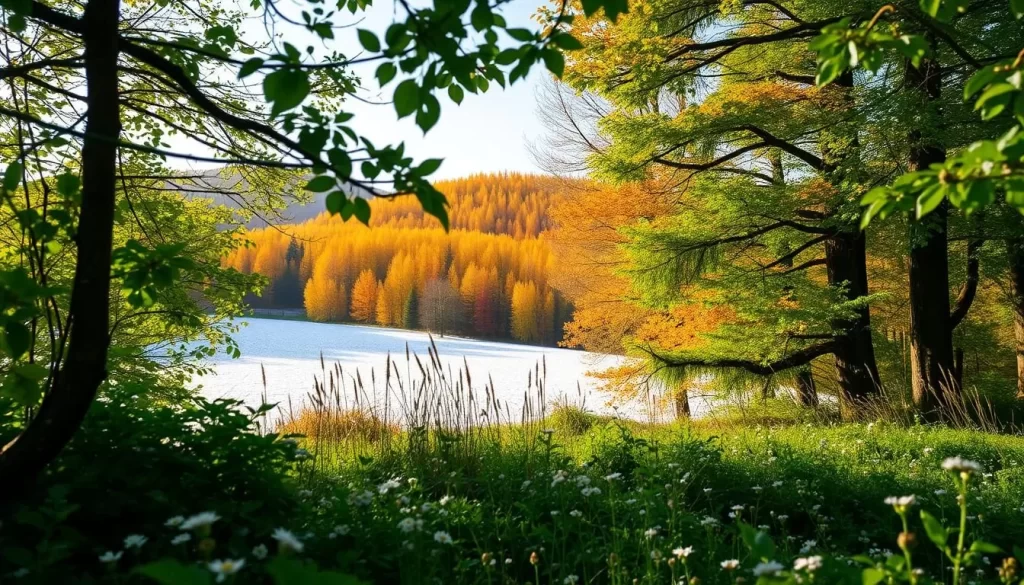
Spring: Cherry Blossoms and Mild Days
Spring is a magical time to visit. The weather is mild, and cherry blossoms paint the landscape in vibrant hues. Gentle spring days are perfect for exploring parks, gardens, and charming towns. This season also marks the start of outdoor events, making it ideal for travelers who enjoy nature and fresh beginnings.
Fall: Wine Festivals and Crisp Breezes
Fall offers a different kind of magic. The air turns crisp, and the countryside glows with autumn colors. This is the season for wine festivals, where you can savor local flavors and enjoy cooler weather. It’s also a great time for outdoor activities like hiking, as the crowds thin out and the scenery becomes breathtaking.
By planning your trip in the right month, you can align your visit with the season’s highlights. Whether it’s spring’s blossoms or fall’s festivals, understanding these seasonal differences ensures a memorable adventure.
Baden-Württemberg, Germany: Best Months for a Weather-Savvy Trip
May is a hidden gem for travelers seeking the perfect balance of comfort and adventure. This month combines mild weather, blooming landscapes, and fewer crowds, making it an ideal time to explore. Whether you’re strolling through charming streets or attending local festivals, May offers a unique experience that’s hard to beat.
Advantages of Visiting in May
May brings pleasant temperatures, perfect for outdoor activities like hiking or sightseeing. The countryside is alive with vibrant colors, and the air feels fresh and invigorating. You’ll also find fewer tourists compared to peak summer months, ensuring a more relaxed and enjoyable trip.
Local events in May add to the charm. From outdoor markets to cultural celebrations, there’s always something happening. These gatherings provide a great way to immerse yourself in the region’s traditions and connect with the local community.
Balancing Pleasant Weather with Fewer Crowds
One of the biggest perks of traveling in May is the balance between great weather and manageable tourist numbers. You can explore popular attractions without the long lines or crowded spaces. This makes it easier to fully appreciate the beauty and history of the region.
Accommodation prices are also more affordable in May, as it’s slightly off-peak. This allows you to stretch your budget further and enjoy a more comfortable stay. Whether you’re in a bustling city or a quiet village, May offers the best of both worlds.
By choosing May for your trip, you’ll enjoy a smoother, more enjoyable adventure. The combination of mild weather, blooming scenery, and fewer tourists makes it a standout month for travel.
Weather Impacts on Local Culture and Festivals
Seasonal weather directly influences the vibrancy of local events and attractions. From lively summer festivals to cozy winter markets, the climate shapes the rhythm of cultural celebrations. Understanding these patterns helps you plan a trip that aligns with the region’s most vibrant moments.
Outdoor Festivals and Biergartens in Summer
Summer brings a burst of energy to the region. Warm weather encourages outdoor events, from music festivals to traditional biergartens. These gatherings are a cornerstone of local culture, offering a chance to enjoy fresh air, live music, and regional delicacies.
The Bregenz Festival, held from July to August, is a prime example. This event attracts visitors from around the world, blending stunning performances with the natural beauty of the lakeside. The warm summer nights create a magical atmosphere, making it a must-see attraction.
Local food markets also thrive during this season. Farmers and artisans showcase their produce, from fresh fruits to handmade crafts. These markets are a hub of activity, offering a taste of the region’s agricultural abundance. The lively crowd and vibrant stalls make them a highlight of any summer visit.
How Weather Shapes the Festival Experience
Even slight weather changes can transform the festival experience. A sunny day can draw larger crowds, while a sudden rain shower might shift activities indoors. This unpredictability adds a layer of spontaneity to your trip, encouraging you to embrace the moment.
Seasonal weather also influences the types of events held throughout the year. Summer is ideal for outdoor concerts and open-air markets, while cooler months focus on indoor gatherings and festive celebrations. By aligning your visit with the weather, you’ll experience the region’s culture at its best.
Whether you’re sipping a cold drink at a biergarten or exploring a bustling market, the weather plays a key role in shaping your adventure. Embrace the seasonal rhythms, and you’ll create memories that last a lifetime.
Navigating Tourist Crowds and Seasonal Pricing
Traveling during off-peak times can transform your experience, offering both savings and serenity. Avoiding peak seasons means fewer crowds, lower costs, and a more authentic connection to local culture. Whether you’re exploring historic sites or relaxing at a beer garden, off-peak travel ensures a smoother and more enjoyable adventure.
Why Off-Peak Travel is Worth It
One of the biggest advantages of off-peak travel is the cost savings. Accommodation prices drop significantly, and flights are often more affordable. This allows you to stretch your budget further and enjoy a more comfortable stay. Plus, booking in advance can secure even better deals.
Fewer tourists also mean a more relaxed environment. You can explore popular attractions without long lines or crowded spaces. This makes it easier to fully appreciate the beauty and history of your destination. For example, visiting a bustling beer garden in the fall lets you enjoy the atmosphere without the summer rush.
Tips for Making the Most of Off-Peak Travel
- Plan Ahead: Book flights and accommodation early to lock in the best rates.
- Research Local Events: Many cultural festivals and events happen year-round, offering unique experiences without the crowds.
- Embrace Flexibility: Off-peak travel often means fewer tourists, giving you more freedom to explore at your own pace.
Traveling during quieter times also allows you to connect more deeply with the local culture. You’ll have more opportunities to interact with residents and experience traditions firsthand. From cozy winter markets to serene spring gardens, off-peak travel offers a unique perspective on your destination.
By choosing to travel off-peak, you’ll enjoy a richer, more authentic experience. Whether it’s savoring local flavors or exploring historic landmarks, the benefits of off-peak travel are undeniable.
Practical Travel Tips for Every Season
Exploring a new destination requires thoughtful preparation to handle its diverse weather and cultural nuances. Whether you’re visiting during the peak summer months or the quieter winter season, being ready for unexpected changes ensures a smoother trip. Here’s how to pack smart and adapt to local customs for a stress-free adventure.

Packing Essentials for Changing Weather
Weather can shift quickly, so packing versatile clothing is key. For rain, a lightweight waterproof jacket is a must. In colder months, thermal layers and a sturdy pair of boots will keep you warm during snowy conditions. Don’t forget accessories like gloves, scarves, and a compact umbrella for added protection.
Here’s a quick checklist to help you prepare:
- Waterproof gear: Jackets, shoes, and a travel umbrella.
- Layered clothing: Lightweight sweaters, thermal tops, and breathable fabrics.
- Versatile footwear: Comfortable walking shoes for all terrains.
By packing smart, you’ll be ready for any weather surprises your destination throws your way.
Adapting to Local Customs and Transportation
Understanding local customs and transportation systems can make your trip more enjoyable. During peak travel times, public transport can get crowded, so plan your routes in advance. Apps like Google Maps or local transit guides can help you navigate efficiently.
Here are a few tips to blend in seamlessly:
- Learn basic phrases: A simple “hello” or “thank you” in the local language goes a long way.
- Respect local etiquette: Observe how locals interact and follow their lead.
- Use public transport: It’s often the most efficient way to explore, especially in busy cities.
By adapting to local customs and transportation, you’ll enhance your travel experience and connect more deeply with your destination.
Finally, always check the weather forecast and seasonal travel advisories before your trip. This ensures you’re prepared for rain, snow, or any other conditions you might encounter. With these practical tips, you’ll be ready to explore confidently, no matter the season.
Exploring Baden-Württemberg’s Iconic Attractions
Discovering the iconic attractions of this region offers a blend of history, nature, and adventure. From centuries-old landmarks to breathtaking natural parks, there’s something for every traveler. Whether you’re a history buff or an outdoor enthusiast, the region’s diverse offerings ensure an unforgettable experience.
Historic Landmarks and Museums
The region is home to stunning historic landmarks that showcase its rich heritage. Explore castles, churches, and museums that tell stories of the past. These sites offer a glimpse into the architectural and cultural evolution of the area.
Museums here are equally captivating, featuring exhibits that range from art to science. They provide a deeper understanding of the region’s contributions to history and culture. Don’t miss the chance to immerse yourself in these educational and inspiring spaces.
Outdoor Adventures for Every Season
For those who love the outdoors, the region’s hiking trails are a must-visit. Trails like the Albsteig stretch over 222 miles, offering breathtaking views and challenging routes. Whether you’re a seasoned hiker or a casual walker, these paths cater to all skill levels.
In winter, the landscape transforms into a snowy wonderland perfect for ski adventures. The Albtrauf, with its 1,000-foot elevation drop, is a favorite spot for winter sports enthusiasts. Even in colder months, the region’s natural beauty remains a major draw.
Scenic Parks and Local Flavors
The region’s parks are ideal for leisurely walks and picnics. These green spaces provide a peaceful escape from the hustle and bustle of daily life. They’re perfect for families, couples, or solo travelers looking to relax and recharge.
After a day of exploring, indulge in the local food scene. From hearty traditional dishes to modern culinary creations, the region’s cuisine is a treat for your taste buds. Pair your meal with a glass of local wine for the full experience.
Whether you’re hiking through scenic trails, skiing down snowy slopes, or savoring local flavors, the region’s attractions offer year-round appeal. Plan your visit to make the most of these iconic experiences.
Experiencing Authentic German Festivities
Immersing yourself in authentic German festivities offers a unique cultural experience. From lively beer festivals to cozy winter markets, these events bring traditions to life. Each celebration reflects the heart of German culture, making them a must-see for any traveler.

Oktoberfest Insights and Celebrations
Oktoberfest is one of the most iconic parts of German culture. Held annually in Munich, this festival attracts millions of visitors worldwide. The atmosphere is electric, with traditional music, hearty food, and, of course, plenty of beer.
Historical roots trace back to 1810, when it began as a royal wedding celebration. Today, it’s a global phenomenon, showcasing Bavarian traditions. From the colorful parades to the lively beer tents, every part of Oktoberfest is designed to entertain and immerse you in the culture.
If you’re planning to attend, book accommodations early. The festival runs from late September to the first weekend in October, making it a highlight of the fall season.
Magic of Christmas Markets in Winter
Winter brings its own magic with the enchanting Christmas markets. These markets are a beloved part of German holiday traditions. Stroll through stalls adorned with festive decorations, and savor seasonal treats like mulled wine and gingerbread.
Markets typically open in late November and run through December. Cities like Dresden and Nuremberg are famous for their markets, offering a mix of history and holiday cheer. The twinkling lights and festive music create a cozy atmosphere that’s hard to resist.
For a deeper cultural experience, visit smaller towns where markets feel more intimate. These hidden gems often showcase local crafts and traditions, giving you a glimpse into authentic German life.
| Festival | Highlights | Best Time to Visit |
|---|---|---|
| Oktoberfest | Beer tents, traditional music, parades | Late September to early October |
| Christmas Markets | Festive decorations, mulled wine, seasonal treats | Late November to December |
Whether you’re raising a stein at Oktoberfest or sipping mulled wine at a Christmas market, these festivities offer an unforgettable glimpse into German traditions. Plan your visit during these events to experience the culture at its most vibrant.
Analyzing Weather Trends in Major German Cities
Cities like Berlin and Hamburg offer unique climates that can shape your travel experience. Understanding these weather trends helps you plan a smoother and more enjoyable trip. From sudden rain showers to temperature shifts, urban weather patterns can influence everything from transportation to local events.
Urban Climate Insights from Berlin and Hamburg
Berlin’s climate is known for its unpredictability. Summers can be warm, with temperatures reaching up to 75°F, while winters often drop to 23°F. Rain is frequent, so packing a waterproof jacket is essential. These conditions can affect outdoor activities and event schedules, so always check the forecast before heading out.
Hamburg, on the other hand, has a coastal influence. The city experiences milder winters but higher humidity levels. Summers are cooler compared to Berlin, with temperatures averaging around 65°F. This makes it a great time visit for those who prefer moderate weather. However, sudden rain showers are common, so be prepared.
Regional Variations and Their Impact on Travel
Regional weather differences can significantly impact your travel plans. For example, Berlin’s drier summers are ideal for outdoor festivals, while Hamburg’s coastal climate is perfect for leisurely walks along the harbor. Understanding these variations helps you choose the best time visit for your preferred activities.
Here’s a quick comparison of the two cities:
| City | Summer Temperature | Winter Temperature | Rainfall |
|---|---|---|---|
| Berlin | Up to 75°F | As low as 23°F | Frequent |
| Hamburg | Around 65°F | Milder, rarely below 32°F | High humidity, frequent showers |
Planning your visit germany around these weather trends ensures a more comfortable and enjoyable experience. Whether you’re exploring Berlin’s historic sites or Hamburg’s waterfront, being weather-savvy makes all the difference.
For more tips on timing your trip, check out this guide on the .
Optimal Outdoor Activities by Season
Exploring the outdoors in every season offers a unique way to connect with nature and culture. Whether you’re hiking through lush trails or skiing down snowy slopes, there’s always something to enjoy. Each season brings its own set of adventures, making it easy to find activities that suit your interests and the weather.
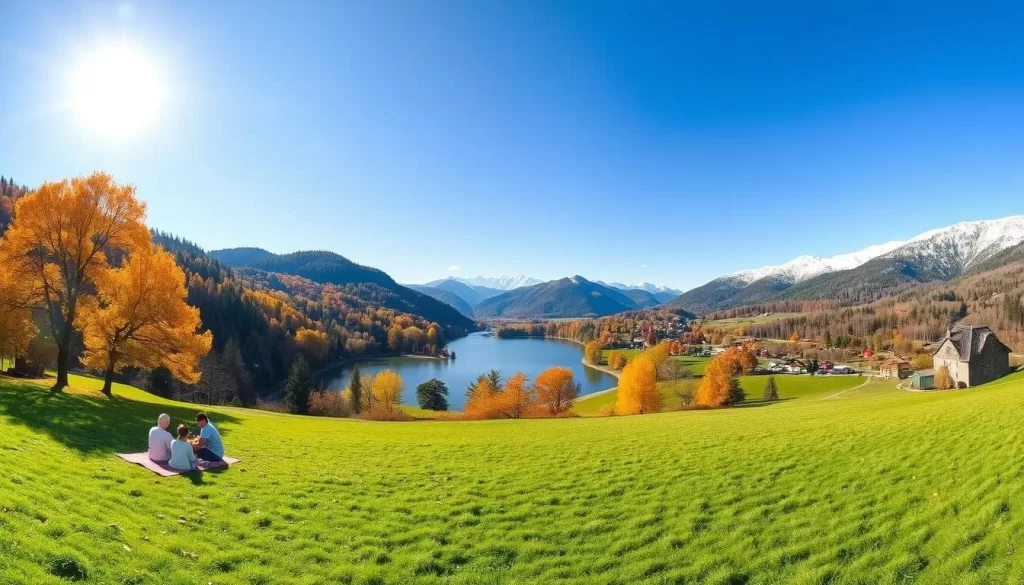
Hiking, Park Visits, and Nature Escapes
Warmer months are perfect for outdoor activity like hiking and exploring parks. Trails like the Albsteig offer breathtaking views and challenging routes for all skill levels. Parks are ideal for leisurely walks or picnics, providing a peaceful escape from daily life.
Spring and summer also bring vibrant landscapes and fresh air. These seasons are great for nature escapes, where you can enjoy blooming flowers and sunny skies. Combining these activities with local wine festivals adds a cultural touch to your adventure.
Winter Sports and Ski Adventures
When the temperature drops, winter sports take center stage. Skiing and snowboarding are popular in mountainous regions, offering thrilling experiences for all levels. The Albtrauf, with its steep slopes, is a favorite spot for winter enthusiasts.
Winter also brings cozy vibes and festive markets. After a day on the slopes, warm up with a glass of mulled wine at a nearby market. This combination of physical activity and cultural immersion makes winter trips unforgettable.
| Season | Activity | Highlights |
|---|---|---|
| Spring/Summer | Hiking, Park Visits | Blooming landscapes, fresh air, wine festivals |
| Fall/Winter | Skiing, Snowboarding | Snowy slopes, festive markets, mulled wine |
Choosing the right outdoor activity based on the season ensures a well-rounded trip. Whether you’re hiking in the sun or skiing in the snow, these experiences create lasting memories. Plan ahead to make the most of your adventure.
Planning a Flexible Itinerary for Your Trip
Crafting a flexible itinerary ensures your trip adapts to unexpected opportunities and seasonal shifts. Whether you’re exploring bustling cities or serene countryside, a dynamic schedule lets you make the most of every moment. Here’s how to plan a trip that balances structure with spontaneity.
Step-by-Step Guide to Flexibility
Start by outlining key activities and destinations, but leave room for adjustments. For example, if you’re visiting during fall, plan for wine festivals but remain open to exploring local markets or scenic trails. Flexibility ensures you don’t miss out on unexpected highlights.
Use weather forecasts and event calendars to guide your plans. If rain is predicted, swap outdoor activity for indoor attractions like museums or cafes. This approach keeps your trip smooth and enjoyable, no matter the conditions.
Balancing Bookings and Spontaneity
Book essential accommodations and transportation in advance, but avoid over-scheduling. For instance, reserve your hotel but leave some days open for impromptu adventures. This balance lets you seize opportunities without feeling tied down.
Consider staying in central locations with easy access to multiple attractions. This reduces travel time and makes it easier to adjust your plans on the go. Flexibility in your schedule enhances your overall experience.
Budget-Friendly Travel Tips
Traveling during off-peak periods like fall can save you money. Accommodation and flights are often cheaper, and popular attractions are less crowded. This allows you to stretch your budget further while enjoying a more relaxed trip.
Here’s a quick comparison of peak and off-peak travel benefits:
| Travel Period | Advantages | Tips |
|---|---|---|
| Peak (Summer) | Lively festivals, warm weather | Book early to secure availability |
| Off-Peak (Fall) | Lower costs, fewer crowds | Stay flexible to explore local events |
By planning a flexible itinerary, you’ll create a richer and more rewarding trip. Embrace spontaneity, and you’ll discover hidden gems and unforgettable moments along the way.
Conclusion
Planning your adventure with the right timing ensures a memorable and smooth experience. By leveraging seasonal weather trends and cultural events, you can make the most of your visit. From packing essentials to flexible itineraries, these tips help you stay prepared for any surprises.
Visiting during shoulder seasons like May offers a perfect balance of pleasant weather and fewer crowds. Destinations like the Bavarian Alps shine during this time, offering breathtaking views and outdoor activities. Local festivals add a cultural touch, making your trip even more special.
Use this guide as a checklist to plan your next adventure. Whether you’re exploring the Bavarian Alps or attending local events, proper planning ensures an unforgettable experience. For more resources and travel deals, sign up and start your journey today!
The above is subject to change.
Check back often to TRAVEL.COM for the latest travel tips and deals.
